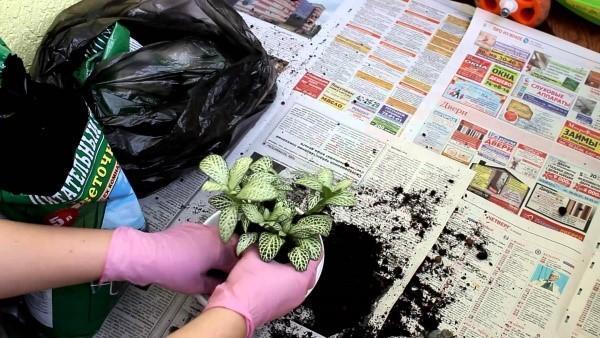Fittonia transplant: when and what to transplant a plant
 As with all indoor plants, transplanting Fittonia is one of the mandatory procedures for growing it. The soil in the pot is quickly depleted as the flower loves to eat deliciously. And the bush itself quickly becomes cramped. If your plant's crown diameter has long outgrown the size of a flowerpot, it's time to start transplanting Fittonia.
As with all indoor plants, transplanting Fittonia is one of the mandatory procedures for growing it. The soil in the pot is quickly depleted as the flower loves to eat deliciously. And the bush itself quickly becomes cramped. If your plant's crown diameter has long outgrown the size of a flowerpot, it's time to start transplanting Fittonia.
Transfer frequency
Fittonia is fast growing. If you do not touch it, then the bush quickly outgrows its pot. As a result, its appearance suffers: due to tightness, leaves may begin to dry out. To prevent this, young Fittonias should be replanted annually. Adult specimens growing in larger flowerpots can be transplanted once every three years.
What kind of pot does Fittonia need
The choice of a flowerpot dictates the peculiarity of the plant's root system. It is superficial, with many small roots. Accordingly, the flower does not need large pots. Its roots will still not reach the bottom of the container soon, but the earth will dry out for a long time. But this is already fraught with diseases and even the death of the plant. Wide, flat, bowls are what you need.
A prerequisite is the presence of good drainage holes in the pot.
What kind of soil does a flower like
When choosing a substrate, one should take into account the "gluttonous" nature of the flower and its love for moisture. The soil should be nutritious, but not heavy. In addition, since light, crumbly earth dries quickly, charcoal must be added to the composition. It is needed in order to:
- retain moisture in the pot, preventing the soil from drying out;
- prevent the development of pathogenic bacteria and fungi in a moist substrate.
Fittonia grows best in acidic soil.
A fertile and loose soil mixture is not difficult to make at home by mixing:
- 3 shares of leafy land;
- 1 beat each peat, sand and humus.
Fittonia transplant: how to do it right
It is better to transplant Fittonia using the transshipment method. Place a sufficiently thick drainage layer on the bottom of the new container. It can be pebbles or expanded clay. Pour some fresh soil on top. Remove the bush from the pot, carefully walking along the walls with a knife (if it is difficult to remove). Slightly remove the top layer of the earth and install in a new flowerpot. It remains only to fill up the voids, tamp and water a little.